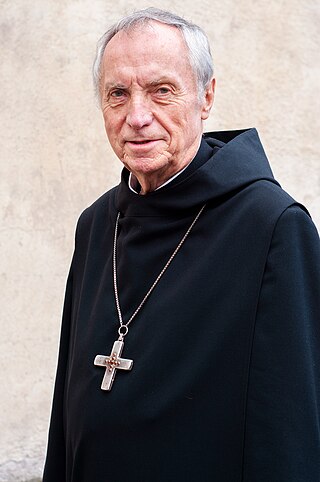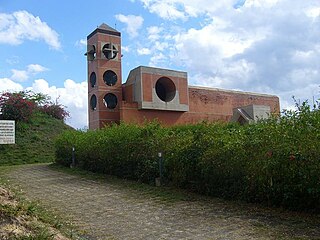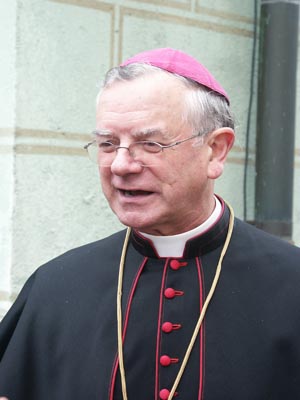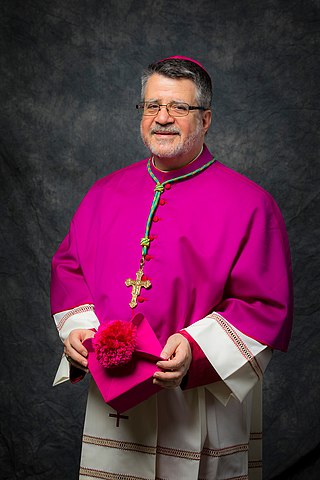Related Research Articles

The Benedictines, officially the Order of Saint Benedict, are a monastic religious order of the Catholic Church following the Rule of Saint Benedict. They are also sometimes called the Black Monks, in reference to the colour of their religious habits. They were founded by Benedict of Nursia, a 6th-century monk who laid the foundations of Benedictine monasticism through the formulation of his Rule of Saint Benedict.

In the Catholic Church, a religious order is a community of consecrated life with members that profess solemn vows. They are classed as a type of religious institute.

The Benedictine Confederation of the Order of Saint Benedict is the international governing body of the Order of Saint Benedict.

Canons regular are priests who live in community under a rule and are generally organised into religious orders, differing from both secular canons and other forms of religious life, such as clerics regular, designated by a partly similar terminology.

The mozzetta is a short elbow-length sartorial vestment, a cape that covers the shoulders and is buttoned over the frontal breast area. It is worn over the rochet or cotta as part of choir dress by some of the clergy of the Catholic Church, among them the pope, cardinals, bishops, abbots, canons and religious superiors. There used to be a small hood on the back of the mozzetta of bishops and cardinals, but this was discontinued by Pope Paul VI. The hood, however, was retained in the mozzette of certain canons and abbots, and in that of the popes, often trimmed in satin, silk or ermine material.
The papal household or pontifical household, called until 1968 the Papal Court, consists of dignitaries who assist the pope in carrying out particular ceremonies of either a religious or a civil character.

The Beuronese Congregation, or Beuron Congregation, is a union of mostly German or German-speaking religious houses of both monks and nuns within the Benedictine Confederation. The congregation stands under the protection of Saint Martin of Tours.

A territorial abbey is a particular church of the Catholic Church comprising defined territory which is not part of a diocese but surrounds an abbey or monastery whose abbot or superior functions as ordinary for all Catholics and parishes in the territory. Such an abbot is called a territorial abbot or abbot nullius diœceseos. A territorial abbot thus differs from an ordinary abbot, who exercises authority only within the monastery's walls or to monks or canons who have taken their vows there. A territorial abbot is equivalent to a diocesan bishop in Catholic canon law.

Casamari Abbey is a Cistercian abbey in the Province of Frosinone, Lazio, Italy, about 10 kilometers east-south-east of Veroli.

Notker Wolf is a German Benedictine monk, priest, abbot, musician, and author. He is a member of St. Ottilien Archabbey located in Bavaria, Germany, which is part of the Benedictine Congregation of Saint Ottilien. He previously was elected and served as the ninth Abbot Primate of the Benedictine Confederation of the Order of Saint Benedict. He was elected to his position as Abbot Primate in 2000 and ended his final term in 2016.

San José Abbey, Güigüe, Venezuela, is a Benedictine abbey of the Congregation of Missionary Benedictines of Saint Ottilien. Currently located to the south of Lago de Valencia, the monastic community was originally established as a mission procure in Caracas following World War I. Caracas' expansion restrained the development of the abbey, and in the late 1980s the monks relocated to Güigüe. The community's superior is Fr Abbot José María Martínez Barrera.
The Canons Regular of the Lateran (CRL), formally titled the Canons Regular of St. Augustine of the Congregation of the Most Holy Savior at the Lateran, is an international congregation of an order of canons regular, comprising priests and lay brothers in the Catholic Church. They received their present name from Pope Eugene IV in 1446.

The Abbot Primate of the Order of St. Benedict serves as the elected representative of the Benedictine Confederation of monasteries in the Catholic Church. While normally possessing no authority over individual autonomous monasteries or congregations, he does serve as a liaison to the Vatican on behalf of the Benedictines, promotes unity among Benedictine monasteries and congregations, and represents Benedictines at religious gatherings throughout the world. He resides in Rome, Italy, at Sant'Anselmo all'Aventino which serves, because he is Abbot Primate, as the "Primatial Abbey of Sant'Anselmo." He appoints a Rector to oversee the College of Sant'Anselmo, serves as the "Grand Chancellor" of the Pontificio Ateneo Sant'Anselmo, and appoints a Rector to oversee the Church of Sant'Anselmo.
The Subiaco Cassinese Congregation is an international union of Benedictine houses within the Benedictine Confederation. It developed from the Subiaco Congregation, which was formed in 1867 through the initiative of Dom Pietro Casaretto, O.S.B., as a reform of the way of life of monasteries of the Cassinese Congregation, formed in 1408, toward a stricter contemplative observance, and received final approval in 1872 by Pope Pius IX. After discussions between the two congregations at the start of the 21st century, approval was given by Pope Benedict XVI in 2013 for the incorporation of the Cassinese Congregation into its offshoot, the Subiaco Congregation. The expanded congregation was given this new name.
St Otmar's Abbey, Uznach, Switzerland, is a monastery of the Congregation of Missionary Benedictines of Saint Ottilien. It was established in the wake of World War I to expand the Congregation's resources beyond Germany. To this day, the monastery continues to procure funds and send personnel to Benedictine missions in the Global South. The current superior of the monastic community is Fr Adelrich Staub, Prior Administrator.
Incarnation Conventual Priory, Agbang, Kara, Togo, is a Benedictine monastery of the Congregation of the Missionary Benedictines of Saint Ottilien. Established in 1985 by Frère Boniface Tiguila, the monastery is currently home to 28 monks. Conventual Prior Fr Bernard Anaté is the community's superior.
The Abbey of St. Maurus is a Tanzanian Benedictine monastery of the Congregation of Missionary Benedictines of Saint Ottilien in Hanga, Ruvuma Region. Established in 1956 by Abbot-Bishop Eberhard Spiess as a formation house for African monastic candidates, the monastery is currently home to 122 monks. The abbey operates schools and a dispensary for the people of the local village and a seminary for the Roman Catholic Archdiocese of Songea.

Viktor Josef Dammertz was a German Benedictine monk of St. Ottilien Archabbey located in Bavaria, Germany, which is part of the Benedictine Congregation of Saint Ottilien. He was elected and served as the sixth Abbot Primate of the Benedictine Confederation of the Order of Saint Benedict from 1977-1992. He was nominated by Pope John Paul II as Bishop of the Diocese of Augsburg 24 December 1992, consecrated 30 January 1993, and resigned 9 June 2004.

Elias RIchard Lorenzo, OSB is an American prelate of the Catholic Church who has served as an auxiliary bishop for the Archdiocese of Newark in New Jersey since 2020.

Hildebrand de Hemptinne was a Belgium Benedictine monk of Beuron Archabbey, the second Abbot of Maredsous Abbey, and the first Abbot Primate of the Order of St. Benedict and the Benedictine Confederation.
References
- ↑ Annuario Pontificio 2012 (Libreria Editrice Vaticana. ISBN 978-88-209-8722-0), pp. 1411–1413
- ↑ Annuario Pontificio 2012, pp. 1414–1419
- ↑ Annuario Pontificio 2012, pp. 1419–1422